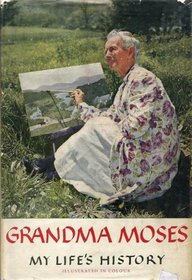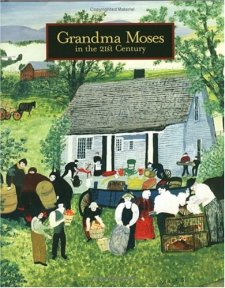 September
07
September
07
Tags
Grandma Moses’ Emancipation Through Art and Duty
 On the 7th of September 1860, American folk artist Anna Mary Robertson Moses, better known as Grandma Moses, was born in Greenwich, New York, the US. Little in her early years indicated the artistic path that her life would eventually follow. As a farmer’s daughter she was expected to do her chores, learn how to cook and clean, and marry and raise a family of her own. Anna Mary did just that. In 1886, she worked for the James family where she met Thomas Moses; the two were married within a year. Soon after the ceremony, the newlyweds travelled by train to Virginia where they managed a farm. A few years passed though, and homesick for his home in New York, Thomas Moses moved his wife and five children to a farm in Eagle Bridge. Tragically, Thomas Moses died of a heart attack in 1927. After her husband’s death, with more time on her hands, Anna Mary took up embroidery and stitched beautiful pictures on cloth. However, one of her sisters saw how painstaking the work was and suggested that Anna Mary paint her pictures instead. And with that one suggestion, a new career was born. At the age of seventy-eight, when most folks simply retire, Anna Mary, soon to be known by the nickname Grandma Moses, became a painter. Her work was discovered by an art dealer in 1938 who gave her the sobriquet by which she became world-famous. Grandma Moses enjoyed huge popularity from the 1940s onwards up until her death in 1961 at the age of 101.
On the 7th of September 1860, American folk artist Anna Mary Robertson Moses, better known as Grandma Moses, was born in Greenwich, New York, the US. Little in her early years indicated the artistic path that her life would eventually follow. As a farmer’s daughter she was expected to do her chores, learn how to cook and clean, and marry and raise a family of her own. Anna Mary did just that. In 1886, she worked for the James family where she met Thomas Moses; the two were married within a year. Soon after the ceremony, the newlyweds travelled by train to Virginia where they managed a farm. A few years passed though, and homesick for his home in New York, Thomas Moses moved his wife and five children to a farm in Eagle Bridge. Tragically, Thomas Moses died of a heart attack in 1927. After her husband’s death, with more time on her hands, Anna Mary took up embroidery and stitched beautiful pictures on cloth. However, one of her sisters saw how painstaking the work was and suggested that Anna Mary paint her pictures instead. And with that one suggestion, a new career was born. At the age of seventy-eight, when most folks simply retire, Anna Mary, soon to be known by the nickname Grandma Moses, became a painter. Her work was discovered by an art dealer in 1938 who gave her the sobriquet by which she became world-famous. Grandma Moses enjoyed huge popularity from the 1940s onwards up until her death in 1961 at the age of 101.
She drew her main inspiration for her rustic scenes from stock imagery such as the popular Currier and Ives prints of American life, which she sometimes used as literal grids. Grandma Moses’ work created a repository of bucolic sentiment in an industrial world, as she depicted rural scenes that merge family and community, rendering the joys of work, togetherness, collective sacrifice and collective ce lebration. Often the stories underlying Moses’ art were stressed more than the artworks themselves. Critics said her reputation outran her aesthetic skills and that, by the standards of art, Moses was not a very good painter. At times, her work was dismissed as illustration. Nevertheless, exhibitions of Moses’ art have been featured at museums and galleries throughout the United States. Travelling shows, sponsored by such organizations as the U.S. Information Agency (USIA) and the Smithsonian Institution, Washington, D.C., received large audiences while travelling throughout Europe, as well as in North America.
lebration. Often the stories underlying Moses’ art were stressed more than the artworks themselves. Critics said her reputation outran her aesthetic skills and that, by the standards of art, Moses was not a very good painter. At times, her work was dismissed as illustration. Nevertheless, exhibitions of Moses’ art have been featured at museums and galleries throughout the United States. Travelling shows, sponsored by such organizations as the U.S. Information Agency (USIA) and the Smithsonian Institution, Washington, D.C., received large audiences while travelling throughout Europe, as well as in North America.
It is hard to tell then whether it was the art or rather her vigorous and inspirational persona that drew the attention of the public. After all, this seventy-something year old grandma proved that a woman can be successful both within the realm of her own family and pursue a successful and self-fulfilling career as well. “A homespun feminist who advocated women’s suffrage on the grounds that women “have to make a living just the same as the men do, so why should they not have a say-so?,” Moses retained a realistic opinion of the difficulty a woman would experience in attempting to combine a traditionally male “career” with raising a family. She showed in her own life, as well as in her paintings, a passionate need to escape from the domestic confinement of a “lady’s” lot. That she managed very largely to do so, first through her farm work and later through her paintings, without giving up her family life, is an impressive achievement, based on her inexhaustible energy, stubbornness, some luck, and a  well developed sense of humor.” (Jean McMahon Humez, The Life and Art of Anna Mary Robertson Moses (Review); Woman’s Art Journal, Vol. 1, No. 2, Autumn, 1980 – Winter, 1981). In her autobiographical book Grandma Moses: My Life’s History (1951), Anne Mary testified the incredible strength and determination to fulfil her own life. She said: “I have written my life in small sketches, a little today, a little yesterday, as I have thought of it, as I remember all the things from childhood on through the years, good ones, and unpleasant ones, that is how they come out and that is how we have to take them. I look back on my life like a good day’s work, it was done and I am satisfied with it. I was happy and contented, I knew nothing better and made the best out of what life offered. And life is what we make it, always has been, always will be.”
well developed sense of humor.” (Jean McMahon Humez, The Life and Art of Anna Mary Robertson Moses (Review); Woman’s Art Journal, Vol. 1, No. 2, Autumn, 1980 – Winter, 1981). In her autobiographical book Grandma Moses: My Life’s History (1951), Anne Mary testified the incredible strength and determination to fulfil her own life. She said: “I have written my life in small sketches, a little today, a little yesterday, as I have thought of it, as I remember all the things from childhood on through the years, good ones, and unpleasant ones, that is how they come out and that is how we have to take them. I look back on my life like a good day’s work, it was done and I am satisfied with it. I was happy and contented, I knew nothing better and made the best out of what life offered. And life is what we make it, always has been, always will be.”










I started writing late in life, and she has been my inspiration
LikeLiked by 1 person
I hope to be able to look back on my life one day as she did and see it as a life well lived. I’ll consider myself lucky if I have that feeling.
LikeLiked by 1 person
Reblogged this on Lenora's Culture Center and Foray into History.
LikeLike
She is indeed an inspiration. Her collection is at the Bennington Museum in Bennington, VT. Well worth a visit!
LikeLike